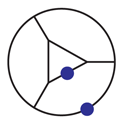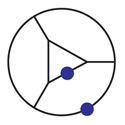In full color
Quantum chromodynamics (QCD) is the theory explaining the binding of color-charged quarks into hadrons, where the interaction among the quarks is mediated by massless gluons. The scattering amplitudes of gluons have important practical relevance to collider physics, but actually computing these amplitudes is very complicated. Calculations are therefore performed perturbatively in the strength of what is called the gauge-coupling constant, which is a measure of the interaction between quarks and gluons.
A theory related to QCD, called maximally supersymmetric Yang-Mills theory, appears to allow the gluon scattering amplitudes to be computed exactly at all orders in perturbation theory, provided one assumes there is an infinite number of colors. However, since there are only three colors in QCD, it is important to extend the gluon scattering amplitudes computation in the Yang-Mills theory to a finite number of colors.
In a paper appearing in Physical Review D, Zvi Bern and collaborators at UCLA, Stanford University, and Pennsylvania State University, and at the CEA in Saclay, France, provide an important step in this direction. Using sophisticated techniques, the authors compute the scattering amplitudes of four gluons for any number of colors at four orders in the gauge coupling expansion.
Bern et al. rely on techniques that may ultimately provide a key input for the computation of scattering amplitudes of gravitons in a related gravity theory. Their results provide hints towards the first quantum mechanically consistent pointlike theory of gravity. – Alin Tirziu





